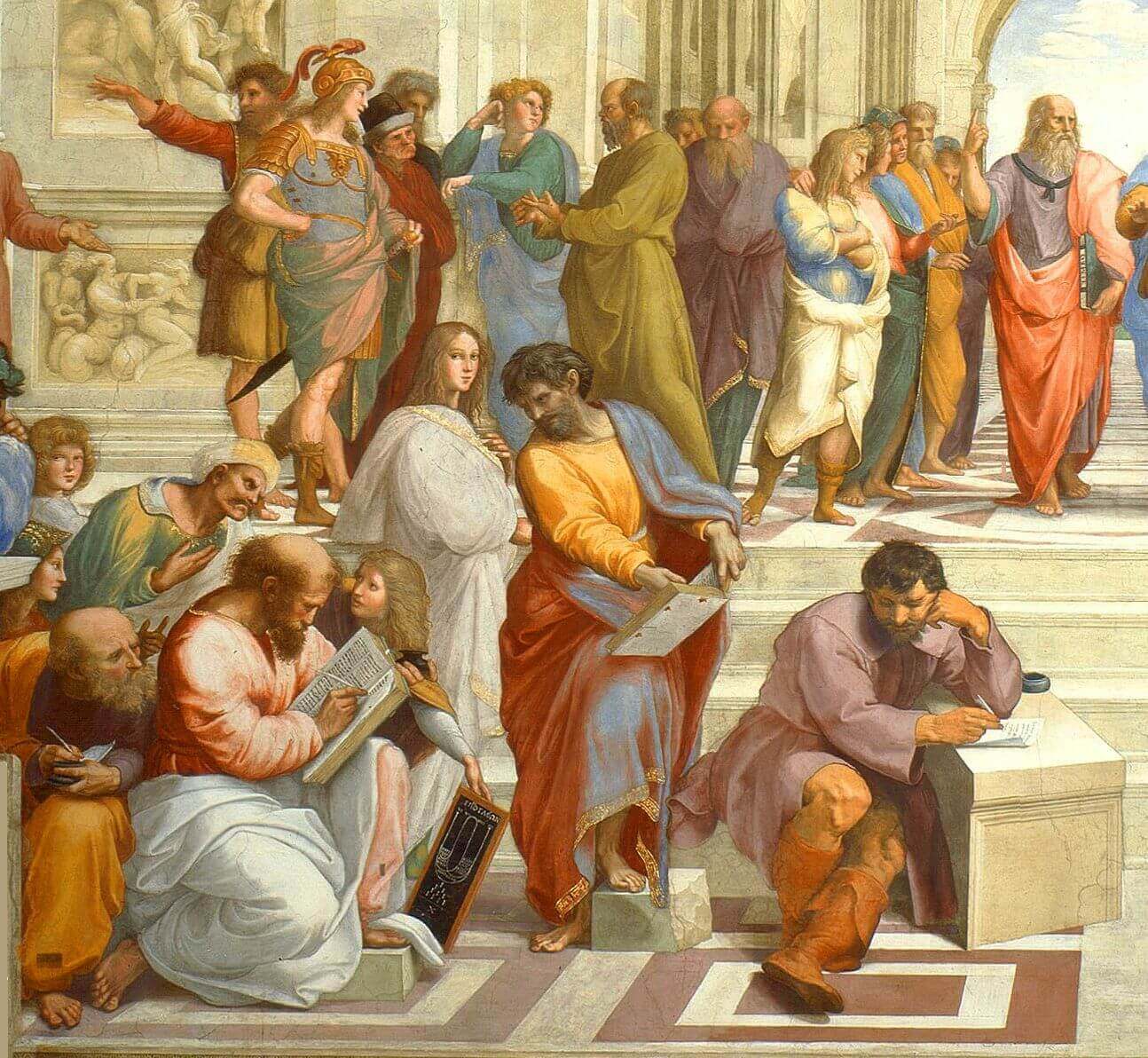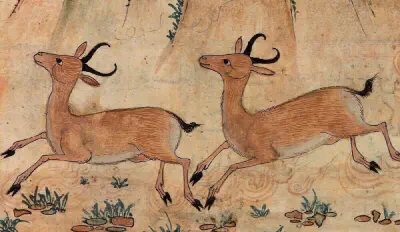Life
Parmenides was a philosopher from the city of Elea, a Greek colony on the Italian peninsula. He was born some time around 515 BCE into a wealthy family. It was said that he had a sharp legal mind, and he was responsible for drawing up the laws of the city. He may also have been a student of the philosopher Xenophanes of Colophon, although this is disputed; and there is evidence he was influenced by the Pythagorean philosophers.
Other than this, we have very little reliable biographical information on Parmenides. Nevertheless, the single work he authored has had a profound influence on the traditions of philosophy that find their origins in Ancient Greece.
The poet-philosopher
Parmenides’s single philosophical work was called On Nature, although it is likely that the title was given to the work long after its completion. As a work of philosophy, On Nature is unusual in that it is written in the form of a poem. Although this is not unique: much later, the philosopher Lucretius (c. 99 – 55 BCE) would also write an epic philosophical treatise on nature through the medium of verse.
Parmenides’s poem is famously difficult to interpret; and this difficulty is compounded by the fact that of the original eight hundred verses, only just under one hundred and sixty lines have survived. Of the lines that survive, some are so fragmentary that they consist only of a single word; and the complete work is one that scholars have patchworked together from a wide range of later sources.
Philosophy
Parmenides’s poem is divided into three parts. The first is a proem, or a preamble. This is followed by two further sections, one called ‘The Way of Truth’, and one called ‘The Way of Opinion.’ Most of the preamble and a substantial chunk of the Way of Truth have survived; meanwhile, many of the Way of Opinion sections have been lost (clearly later philosophers were much more concerned with preserving truths than opinions!).
Celestial journeys
The opening preamble is very strange indeed. In it, Parmenides recounts a mystical journey on a flying chariot, accompanied by the daughters of the sun, where he passes through the ‘gate of the paths of night and day’ to meet with a goddess, (whom some scholars identify as the Nyx, goddess of the Night).
The following extract describes his journey in mystical, almost ecstatic terms:
The axle in the axle-box roared from its socket as it blazed — for it was driven on by two whirling wheels on either side — while the maidens, daughters of the sun, hastened to escort it, having left the house of Night for the light and pushed back with their hands the veils from their heads.
After this, Parmenides meets with the goddess, and she unveils the great truths of existence. The goddess says to him:
Young man, companion to the immortal charioteers […] You must learn all things,both the unwavering heart of persuasive truthand the opinions of mortals in which there is no true trust.Translation from Jonathan Barnes (p. 131)
The rest of the poem follows this two-part structure. First it sets out the goddess-revealed truth; and then it plunges into the opinions of mortals.
These two ways stand in stark opposition. For Parmenides, you cannot be sort of on the right path. The Way of Opinion is ‘a trail devoid of all knowledge.’ You are either in the realm of truth, or the realm of opinion; and the split between the two is vast and unbridgeable.
The Way of Truth
But what is the Way of Truth? At this point, things get more difficult. Parmenides’s whole philosophy hinges on the idea of the non-existence of nothingness. In the Sophist, Plato quotes the relevant passage from Parmenides’s poem:
Never will this prevail, that what is not is: restrain your thought from this road of inquiry. Plato, Sophist 237 A
If this makes your head spin, you’re not alone. But let’s try to break it down. The idea of ’nothing’ is a tricky one. Often, we treat ’nothing’ as something that exists alongside other things, as in the following dialogue:
Philosopher 1: What’s in the box?
Philosopher 2: A cat!
[The cat jumps out… a few seconds pass.]
Philosopher 1: What’s in the box now?
Philosopher 2: Nothing!
But there is a significant difference between these two answers. When we say that a cat is in the box, we are saying that a cat is a thing that exists, and this thing is in the box. But we say that nothing is in the box, we’re not talking about ’nothing’ as a thing that exists in the box. ‘Nothing’ doesn’t refer to any existing thing at all. Nothing simply doesn’t exist.
But if nothing doesn’t exist, Parmenides reasons, then the only thing that can exist is being itself. And what is ‘being’? Parmenides argues that once we have got rid of the idea of nothingness, then:
Only one story, one road, now is left: that it is. And on this there are signs in plenty that, being, it is ungenerated and indestructible, whole, of one kind and unwavering, and complete. Nor was it, nor will it be, since now it is, all together,one, continuous.
This is tricky stuff. But Parmenides’s argument is that if nothingness does not exist, then there is only being. And this being cannot be generated (it cannot come out of nothingness) or destroyed (it cannot go back into nothingness). So being fills up everywhere. It is single, unchanging, complete, and continuous.
But this has unsettling implications. If being is unchangeable, and if non-being cannot give rise to being, then nothing can ever come into existence or go out of existence. Again, Parmenides writes as follows:
How might what is then perish? How might it come into being? For if it came into being it is not, nor is it if it is ever going to be.
The startling consequence of this is that nothing ever changes. As Catherine Osborne writes, ’nothing varies in any way across space or time. What is just is, and it can’t be anything else’ (p. 44).
The Way of Opinion
This leaves us with the question of why it is that things seem nevertheless to change. And this takes us from the Way of Truth to his Way of Opinion.
Perhaps only ten percent of the Way of Opinion section of the poem is still extant, and much of it is pretty scrappy and baffling. But what Parmenides seems to be doing in the final part of his poem is exploring how it is that stuff seems to change, even if logic dictates that things are single, eternal and unchanging.
So what…?
At this point, you might be asking: So what? But there are some important implications to Parmenides’s ideas. One thing is that Parmenides drives a wedge between how things really are, and how they appear to be. This split was already identified by Thales, who said however things appear, they are in reality all made of water. But with Parmenides, this split between appearance and reality becomes a huge gulf. It suggests that everything we think we know about the world is wrong.
The other important implication of Parmenides’s philosophy is that it opens up a long line of philosophical argument about what it means to exist at all. What does it mean to say that something is? This is a question that still preoccupies (some) philosophers down to the present day.
Waiting for the goddess?
Parmenides is an enigmatic, difficult and puzzling philosopher. He is as provocative as he is divisive. In dividing the Way of Truth and the Way of Opinion so starkly, he seems to be pessimistic about our ability to say what is true.
And perhaps — unless a kindly goddess happens to pass by, pick us up in her chariot, and explain things to us face to face — our odds of saying whether we are on the Way of Truth or else on the Way of Opinion remain frustratingly slim.
Further Reading
Books
I used Jonathan Barnes’s Early Greek Philosophy (Penguin Book 1987) as the source of the quotes from Parmenides.
Catherine Osborne’s Presocratic Philosophy: A Very Short Introduction (Oxford University Press 2004) is particularly excellent on Parmenides. The quote above comes from this book.
Online Resources
Buddhist-inclined readers may find that this talk of the Way of Opinion and the way of truth is ringing some bells. If so, try this article on Parmenides and the Buddhist philosopher Nāgārjuna.



